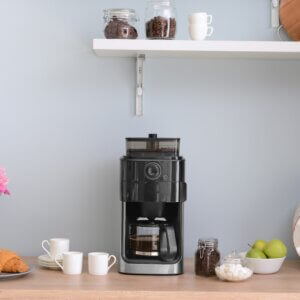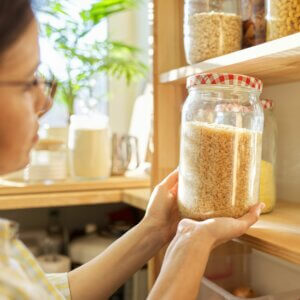


How We Organized the Kitchen
- Dedicated Space: We designated a pull-out drawer in the fridge for our mom’s meals and snacks, clearly labeling it “Gina’s Meals and Snacks.” If your fridge doesn’t have a dedicated drawer, a specific shelf works just as well. Label it and practice the new setup with your loved one to help them feel familiar and confident navigating the space.
- Left Side: We placed breakfast items like yogurt, fruit, and protein-rich egg muffins here, as these are the items she usually starts her day with. This arrangement helps her find her breakfast easily and independently.
- Right Side: Prepared lunches and dinners in clearly labeled containers.
- Milk Bottles: Switching to glass milk bottles with clear labels like “Milk for Coffee” and “Milk for Cereal” made things easier. Even though cereal is no longer part of her breakfast, keeping the familiar label helps reduce confusion.
- Designated Shelf: One shelf holds a labeled cereal container and a snack bin with healthy options like nuts and dried fruit.
- Door Label: Adding a “Pantry” sign not only helped her recognize the space as her Alzheimer’s progressed but also provided a clear visual cue, aiding her memory and reducing confusion.
- Streamlined Setup: We created a coffee station with everything she needs in one spot: her electric kettle, coffee, and mug.
- Extra Help: If she needs guidance, labels like “Push Here” on the kettle and step-by-step instructions posted nearby simplify the process. You can also consider using color-coded labels for different tasks or providing a visual schedule for the day’s meals.
Adapting Over Time
- First 5 Years: Our mom used the microwave to reheat meals independently.
- Years 6–7: We started helping with food warming, but she still easily feeds herself.
Practical Tips for Caregivers
- Involve Your Loved One: Help them organize their space. This approach builds ownership and familiarity and empowers them to maintain control over their environment, which can be comforting and reassuring. You can also encourage them to participate in meal planning and preparation, as this can give them a sense of purpose and accomplishment.
- Simplify Choices: Limit options to two or three. For example, ask, “Should breakfast items be on the left or the right?”
- Stay Flexible: Regularly reassess and adjust as their needs change.
- Start Small: Even tiny changes—like rearranging the order of items in the fridge or pantry—can make a big difference in daily routines. These small adjustments can make tasks more manageable and less overwhelming for your loved one, and they are a testament to your effectiveness as a caregiver.
With a few thoughtful adjustments, you can create a kitchen that empowers your loved one and helps them confidently navigate their day. These small steps can significantly impact their independence and overall well-being.





